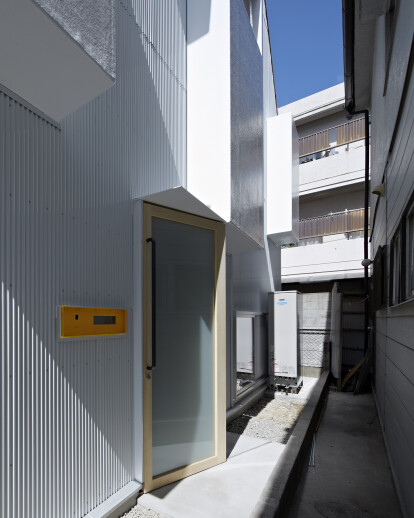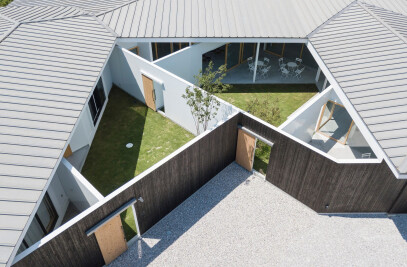Widening interspace for use.
Many of the requests we receive for house design, come with a prerequisite: to provide living space for a nuclear family on an extremely subdivided lot. The usual manner of architecture, developed over the ages in Japan does not apply here. Instead, we think we are in the formative period of a new manner that is developing through a process of design trial and error. This project is no exception. In this dense urban environment, where the outer walls of adjoining houses do not touch, the civil law required a 500mm setback of outer walls ensuring 1000mm of interspace between neighboring houses. We felt we could use this space more effectively. So in this project, we provided an additional 400mm of setback from the boundary of the adjacent land to the North East. That resulted in 1400mm of interspace that could be used for passage, which was 900mm in width from the boundary of the adjacent plot. We then placed an entrance in the middle of the sidewall facing this interspace, which minimized space required within the house for internal passage. The setback also allowed the eaves to be built as high as 9m avoiding the north side slant line. Non-structural walls were pushed outward into this setback from the interior, providing more space for closets etc. And in the same way, facilities such as the toilet were also afforded more room, whilst appearing from the interior to look like furniture with an ambiguous perception of space. Architecture and furniture
Whenever I have the honor of viewing an architect-designed house, I sometimes feel as if the design of the furniture is telling me something. It may be saying, “respect the original space and don’t bring any unnecessary things”, or perhaps it is personifying a strong desire to avoid filling the space with things that do not deserve to be there. Although I cannot say I don’t share that desire, I still aim to create spaces where a variety of things can be brought in and used in everyday life much more freely. In this house, architectural elements such as stairs, a laundry space, closets, handrails and toilets are designed as if they are furniture. Beyond those pieces, there are only floors. As such, architecture and furniture merge and those meanings become relative to each other. In that way I try to create a sense of freedom in the rooms as if the furniture is randomly placed and used by chance. Like choreography notes
I always think that how you deal with stairs is important in houses, especially in small ones. A typical method is to place stairs in the middle of a room, allocating functions on both sides. Although it maximizes usable area, that method makes me wonder if the spatial experience is as rich as it can be when you live, seeing every inch of the house and the stairs all the time. The ceiling of the dining room in this house is 3776mm high, designed that way to make the space under the staircase landing a usable walkway. Because the landing has been made extremely thin, the height below it is 1880mm and above it is 1850mm. Although these are tight dimensions, you can still walk comfortably between the layers, minding your head. I think it is favorable for a house to have such a scale of the human body. For that reason, the dining table was placed over the stair between the ground floor and the first floor leaving space for residents to pass under it. Bodies appear and disappear under the table as residents go up and down the stair. When you enter the house via the sliding door and slip inside the “furniture” of the stairwell, you arrive on the first floor from under the dining table, where you are faced with a big wall receiving sunlight from the south window. You see the white wall softly lit from the north as you turn to step on a small stool to a raised living area. To reach the second floor, you step on the sofa, and then more furniture designed both like a drawer and a stair, and eventually a thin stair. At every step, light conditions change as the direction and the size of space changes. Stairs define the choreography of the spatial experience of this small, thin house. Structure
As the site is located at the rear of a narrow cul-de-sac and delivery of materials by vehicle was difficult, the materials used in the structure were light. For columns and beams, 100mm×100mm H steel sections were used, braced with round bars, and 75mm deck plates were used in the floor construction. This resulted in reduced amounts of steel materials, and the total construction cost was similar to that of a wooden house. The horizontal stiffness of floors was acquired through horizontal bracings of 6mm flat bars and 50mm squared tie beams beneath concave parts of the deck plates. Floors on different levels were fixed to the columns at both ends so that the continuity of stiffness between those was maintained.

































